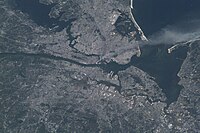
Photo from wikipedia
We evaluated the incidence and risk factors for COVID-19 in a prospectively followed cohort of Fire Department of the City of New York (FDNY) World Trade Center (WTC)-exposed workers, thus… Click to show full abstract
We evaluated the incidence and risk factors for COVID-19 in a prospectively followed cohort of Fire Department of the City of New York (FDNY) World Trade Center (WTC)-exposed workers, thus reducing the potential for selection bias, a limitation in published studies of hospitalized individuals. Participants were retired FDNY WTC-exposed rescue/recovery workers with ≥1 medical visit between 1 March 2020 and 1 August 2021. The cumulative incidence was calculated using self-reported COVID-19 diagnoses. Cox regression was performed to evaluate the association of WTC-exposure and COVID-19, adjusting for history of comorbidities, age, race, work assignment (emergency medical service providers vs. firefighter), and sex. The cumulative incidence of COVID-19 was 130 per 1000. The adjusted models showed the risk of infection was greater in those with highest WTC exposure versus less exposure (hazard ratio (HR) = 1.14 (95% CI 1.00–1.31)). Older age was associated with a lower risk of infection HR = 0.97 (95% CI 0.96–0.98). WTC-associated diseases (obstructive airways disease and interstitial lung disease) were not COVID-19 risk factors. This study is the first to show an association between WTC exposure and the risk of COVID-19. While participants are retired from FDNY work, the youngest individuals may still be in the workforce, explaining why younger age was a significant risk for COVID-19.
Journal Title: International Journal of Environmental Research and Public Health
Year Published: 2022
Link to full text (if available)
Share on Social Media: Sign Up to like & get
recommendations!